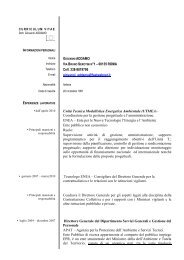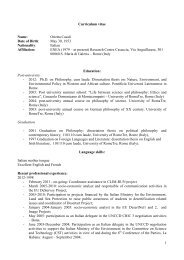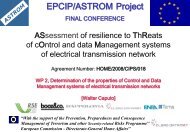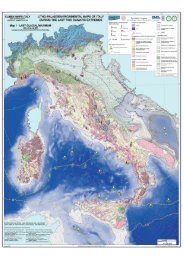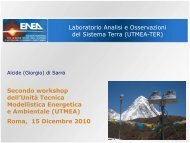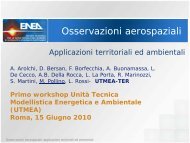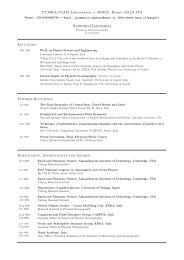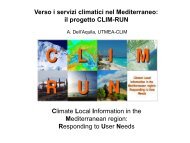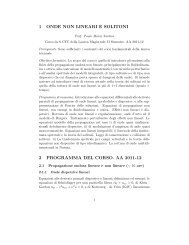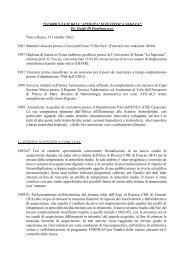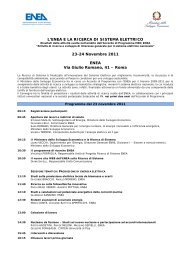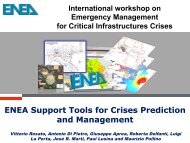State of the Mediterranean Marine and Coastal Environment
State of the Mediterranean Marine and Coastal Environment
State of the Mediterranean Marine and Coastal Environment
You also want an ePaper? Increase the reach of your titles
YUMPU automatically turns print PDFs into web optimized ePapers that Google loves.
Chlorinated pesticides <strong>and</strong> HCB/PCBs<br />
releases by sector, 2008<br />
Number <strong>of</strong> records reported<br />
0 5 10 15 20<br />
Cement production<br />
Metal industry<br />
Oil refining<br />
Production <strong>of</strong> biocides<br />
Pulp <strong>and</strong> paper<br />
Chemical industry<br />
Wastewater<br />
treatment plants<br />
O<strong>the</strong>r<br />
HCB/PCBs<br />
Chlorinated pesticides<br />
Source: MEDPOL; Releases, emissions <strong>and</strong> sources <strong>of</strong> pollutants in <strong>the</strong><br />
<strong>Mediterranean</strong> region. An assessment <strong>of</strong> 2003-2008 trends; 2012.<br />
plants, which may collect pesticides contained in sewage <strong>and</strong><br />
run<strong>of</strong>f waters.<br />
Data published between 1971 <strong>and</strong> 2005 were included in a regional<br />
assessment <strong>of</strong> pollution <strong>of</strong> sediments by certain POPs,<br />
namely polychlorinated biphenyls (PCBs) <strong>and</strong> chlorinated pesticides<br />
like dichlorodiphenyltrichloroethane <strong>and</strong> its degradation<br />
products (DDTs) <strong>and</strong> hexachlorobenzene (HCB) (Gomez-Gutierrez<br />
et al. 2007). Despite <strong>the</strong> shortcomings in <strong>the</strong> combined datasets,<br />
<strong>the</strong> authors were able to conclude that contamination <strong>of</strong><br />
sediments by POPs is more a local problem, mainly associated<br />
with urban/industrial <strong>and</strong> river discharges, as well as with coastal<br />
enclosures (harbours <strong>and</strong> coastal lagoons), ra<strong>the</strong>r than a widespread<br />
issue. They also concluded that <strong>the</strong> nor<strong>the</strong>rn <strong>Mediterranean</strong><br />
coast is <strong>the</strong> area <strong>of</strong> most concern for sediment pollution by<br />
POPs <strong>and</strong> that POPs have declined – with this decline being more<br />
evident for DDTs than for PCBs. This could indicate an ongoing<br />
input <strong>of</strong> PCBs, which highlights <strong>the</strong> need for improved management<br />
<strong>of</strong> <strong>the</strong> potential sources.<br />
The recent MED POL study (UNEP/MAP/MED POL 2011) included<br />
PCBs <strong>and</strong> chlorinated pesticides (DDTs, HCB, aldrin, endrin, dieldrin<br />
<strong>and</strong> lindane). It provides an updated view <strong>of</strong> <strong>the</strong> geographical<br />
distribution <strong>and</strong> trends <strong>of</strong> POPs in biota, summarising <strong>the</strong><br />
data mainly for blue mussels <strong>and</strong> red mullet.<br />
PCBs were found in <strong>the</strong> vicinity <strong>of</strong> industrial <strong>and</strong> urban sites, as<br />
well as around <strong>the</strong> mouths <strong>of</strong> major rivers. Areas <strong>of</strong> concern with<br />
regard to levels <strong>of</strong> PCBs in biota include northwestern <strong>Mediterranean</strong><br />
coastal areas, with generally high levels, especially around<br />
<strong>the</strong> cities <strong>of</strong> Barcelona, Marseille (with <strong>the</strong> highest values <strong>of</strong> up<br />
to 1.500 ng/g dry weight) <strong>and</strong> Genoa. Particularly high levels <strong>of</strong><br />
PCBs were also found in biota from <strong>the</strong> coastal strip from Livorno<br />
to Nice <strong>and</strong> <strong>the</strong> mouths <strong>of</strong> <strong>the</strong> Rhone <strong>and</strong> Ebro rivers (indicating<br />
that rivers <strong>and</strong> wastewater discharges are major sources <strong>of</strong> PCBs).<br />
In <strong>the</strong> Adriatic Sea, PCBs were elevated in biota from <strong>the</strong> eastern<br />
bank <strong>and</strong> along <strong>the</strong> coasts <strong>of</strong> Croatia <strong>and</strong> Albania. Levels were<br />
generally lower in <strong>the</strong> Eastern Basin, but medium to high levels<br />
<strong>of</strong> PCBs were recorded in red mullets from Cyprus <strong>and</strong> Turkey<br />
<strong>and</strong> high values, also related to industrial <strong>and</strong> urban effluents,<br />
were recorded <strong>of</strong>fshore from <strong>the</strong> A<strong>the</strong>ns port <strong>of</strong> Piraeus.<br />
Assessment <strong>of</strong> regional trends in PCBs is made difficult by<br />
changes in analytical <strong>and</strong> reporting methods. At coastal sites in<br />
<strong>the</strong> northwestern <strong>Mediterranean</strong> (France <strong>and</strong> Italy), where trend<br />
analysis is possible, <strong>the</strong> PCB concentrations in biota remained<br />
relatively constant or, in some cases, increased slightly. Similar<br />
trends were recorded at stations in <strong>the</strong> Eastern <strong>Mediterranean</strong><br />
(A<strong>the</strong>ns, Greece, <strong>and</strong> Izmir <strong>and</strong> Mersin, Turkey).<br />
Despite monitoring <strong>of</strong> chlorinated pesticides by MED POL<br />
since <strong>the</strong> 1990s <strong>and</strong> <strong>the</strong> improvement <strong>of</strong> systematic monitoring<br />
during <strong>the</strong> past decade, spatial data coverage is not sufficient<br />
for drawing conclusions about <strong>the</strong> regional distribution<br />
<strong>of</strong> <strong>the</strong>se compounds. Available data indicate that contaminants<br />
are not uniformly distributed throughout <strong>the</strong> <strong>Mediterranean</strong><br />
<strong>and</strong> some hot spots have been identified for specific<br />
pesticides.<br />
In <strong>the</strong> Western <strong>Mediterranean</strong>, areas <strong>of</strong> particular concern include<br />
estuaries (Rhone <strong>and</strong> Ebro), ports, bays <strong>and</strong> gulfs (Barcelona,<br />
Marseille-Fos, Liguria, Nador Lagoon, <strong>and</strong> <strong>the</strong> bays <strong>of</strong> Algiers,<br />
Tunis, Naples, <strong>and</strong> o<strong>the</strong>rs). These areas have moderate levels <strong>of</strong><br />
aldrin, HCB <strong>and</strong> DDTs. There is evidence that river inputs represent<br />
<strong>the</strong> most important source <strong>of</strong> pesticides entering <strong>the</strong> Western<br />
<strong>Mediterranean</strong> Sea.<br />
Several stations along <strong>the</strong> Italian coast <strong>of</strong> <strong>the</strong> Adriatic Sea had<br />
moderate values <strong>of</strong> aldrin <strong>and</strong> dieldrin, while Durres <strong>and</strong> Vlora<br />
Bay (Albania) had very high levels <strong>of</strong> DDTs <strong>and</strong> lindane. Moderate<br />
concentrations <strong>of</strong> lindane <strong>and</strong> DDTs were found in <strong>the</strong> Gulf<br />
<strong>of</strong> Trieste <strong>and</strong> <strong>the</strong> Marche region (Italy), respectively. In <strong>the</strong> Eastern<br />
<strong>Mediterranean</strong>, concentrations <strong>of</strong> DDTs in biota were quite<br />
low, although moderate concentrations <strong>of</strong> DDTs were present in<br />
Izmir Bay (Turkey), at three stations south <strong>of</strong> Cyprus, as well as in<br />
Saronikos, Thermaikos <strong>and</strong> Amvrakikos Gulf (Greece) where <strong>the</strong><br />
concentrations <strong>of</strong> aldrin <strong>and</strong> dieldrin were also very high, probably<br />
due to agricultural activities in <strong>the</strong> area.<br />
The levels <strong>of</strong> chlorinated pesticides in mussels have declined<br />
since <strong>the</strong> 1990s, which is consistent with <strong>the</strong> banning <strong>of</strong> production<br />
<strong>and</strong> use <strong>of</strong> <strong>the</strong>se compounds. The median values <strong>of</strong> pesticides<br />
in mussels from Croatia <strong>and</strong> France exhibit clear decreasing<br />
trends, as do <strong>the</strong> outlier values in <strong>the</strong> data from France. The only<br />
exception seems to be Albania (e.g., Durres <strong>and</strong> Vlora Bay), due<br />
probably to stockpiles <strong>of</strong> obsolete chlorinated pesticides. In Mersin<br />
(Turkey), chlorinated pesticides in mussels are decreasing, although<br />
occasional increases were recorded in Izmir Bay (Turkey).<br />
In general, <strong>the</strong> decrease is slower for DDT than for lindane <strong>and</strong><br />
o<strong>the</strong>r chlorinated pesticides, which is consistent with <strong>the</strong> longer<br />
half-life <strong>of</strong> DDT.<br />
The last two groups <strong>of</strong> POPs that are <strong>of</strong> concern in <strong>the</strong> <strong>Mediterranean</strong><br />
Sea are mostly related to maritime traffic <strong>and</strong> boating.<br />
These are biocides (mainly organotin compounds such as tributyltin,<br />
known as TBT) used in antifouling paints <strong>and</strong> polycyclic<br />
aromatic hydrocarbons (PAHs) resulting from hydrocarbon oil<br />
discharges <strong>and</strong> accidental spills, among o<strong>the</strong>r sources. PAHs are<br />
considered along with oil pollution in <strong>the</strong> next section.<br />
Organotins have been detected in <strong>Mediterranean</strong> waters <strong>and</strong><br />
sediments since <strong>the</strong> late 1980s <strong>and</strong> continue to be present in<br />
substantial concentrations despite <strong>the</strong> ban on <strong>the</strong>ir use in 1990.<br />
TBT degradation is slow, with a half-life ranging from weeks in<br />
shelf waters to years in deep sediments (Abdulla <strong>and</strong> Linden<br />
HUMAN PRESSURE, STATE AND IMPACTS ON MEDITERRANEAN ECOSYSTEMS<br />
47



